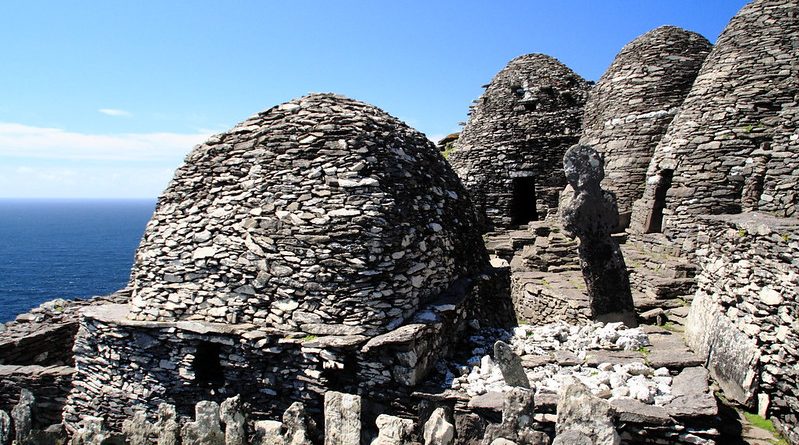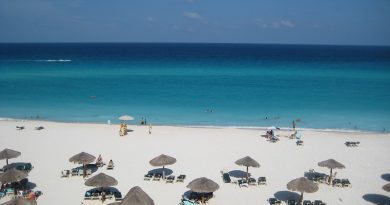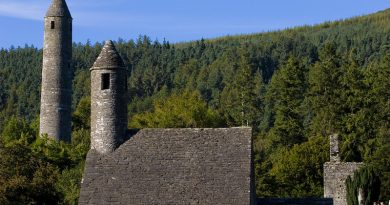Skellig Island (Archangel Michael’s Rock)
Beach Essentials
Where: County Kerry, Southwest coast of Ireland
When: July and August are the hottest months to visit
Happenings: Visit the Unesco protected monastery, spot puffins and other birds and enjoy the clean and sandy nearby beaches
A Trip to the Island
Observed from any vantage-point on the nearby Ring of Kerry, the Skellig Islands are spectacular pinnacles that demand attention. A boat trip eight miles into the Atlantic Ocean to get to the islands is an unusual highlight of a trip to Ireland. The crossing can be awkward, and there are no toilets or facilities on the islands, so bring good warm clothing, something to eat, drink and a camera.
The mind tends to wander on the boat trip from the mainland. The Atlantic is rough, birds cry and dart, plunging into the water at speed before the Skellig rocks which soar 700 ft into the air, on top of which there is a monastery, built hundreds of years ago and still defying the harsh conditions.
History of Skellig Michael
It is only possible to land on the larger island, Skellig Michael, where the remarkable ancient monastery resides. However, excellent views of the other island can be had from there. When the monks first settled on Skellig Michael is a mystery, but the style of building suggests the 6th century onwards. There are many other samples of this style dotted along Ireland’s West Coast, but none in such good condition as the Skellig Michael monastery, and for this reason the island has become a World Heritage Site. The monks lived in beehive rock domes of varying sizes, possibly covered in turf for warmth. Guides who work on Skellig in the Summer season are very knowledgeable and do a good job of describing the lives of the monks who spent their years in solitude.
In A.D. 795, the first Viking attacks from Scandinavia were launched in an attempt to strip Ireland of its riches, and the Skellig settlement was eventually one of those sacked. Little is recorded of the early attacks. However, in A.D. 812, the Skellig monastery was ransacked. Again in 825, as reported in the Annals of Ulster, the Vikings came and this time they took Etgal, the Abbot of Skellig, and starved him to death. Legend tells that in 993 Viking Olav Trygvasson, who was later to become King of Norway and whose son Olav II, was to become patron saint of Norway, was baptised by a Skellig hermit.
Things to See and Do:
The Skellig Experience Centre
In The Skellig Experience Centre you can learn all about the settlements on the island. It is a boost for land lubbers as they can look at recreations of the monastic settlements in a custom built, stone clad, grass roofed, prize winning building located right on the waterfront. In the auditorium, through a short audio-visual presentation you can follow the footsteps of the Skellig monks, and wonder at the legacy of architecture that they left behind. Here too, in the Skellig Experience’s recreated sea cliff you can get to know, by sight and sound, the full variety of seabirds in Skellig. The centre also offers, through artefacts and recreations, the Skellig Lighthouse Experience, with its history, light keepers, and its service to mariners since the 1820’s. It is open daily from 10am to 6pm.
Bird Watching
The Skelligs are great for bird watching. From the boat, you are likely to see the tiny black storm petrels skimming the water for insects. You will also see large yellow headed gannets diving for fish. Between March and August the majority of these birds will be nesting in the Skelligs so it is a hive of activity and a good chance to get up close. A few of the nesting visitors include everyone’s favourites, puffins, as well as fulmars, guillemots, kittiwakes and razorbills. Just a few miles away by boat there is an opportunity to see Puffin Island, which makes no secret of its inhabitants. Outside of the summer months the island is harder to get to. Local boat owners may take you out for a price, or if you are cheeky and lucky enough you may even get to know the lighhouse keeper who makes regular trips to the island, occasionally staying overnight.
Beach Bathing
No pun intended, but the beaches on the South Coast are corkers. There are hundreds of miles of sandy coastline, so it’s not difficult to find a good place.
In Cork, there are the following EU Blue flag beaches:
Barleycove, Garretstown, Garrylucas, Garryvoe, Inchydoney, Owenahincha, Tragumna, Youghal Claycastle, Youghal Front Strand, The Warren (Rosscarbery),White Strand.
In Kerry, the blue flag beacher are:
Ballinskelligs, Ballybunion North, Ballybunion South, Ballyheigue, Banna, Derrynane, Fenit, Inch, Kells, Maherbeg, Rossbeigh, Ventry and White Strand Caherciveen.
While using the beaches in the Cork or Kerry region, do make sure to follow the advice of lifeguards where this service is provided. Read warning signs carefully. Failing that, seek local advice regarding the safety of individual beaches for swimming.
More Information
The Skellig Michael Lighthouse
Photos of the island and the lighthouse
World Heritage Site
Why is Skellig Michael considered a place worth protecting?
Tourist Info: Skelling Experience
Things to do in Skellig
Ring of Kerry Railtours
Timetables and accessibility of trains
By Colin Jennings




